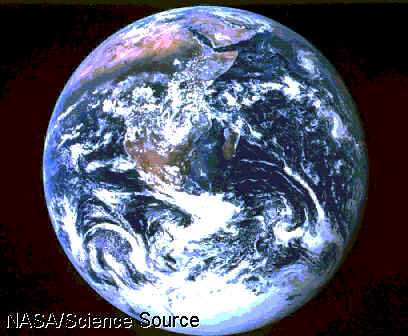|
|
|

Earth, one of the planets in the solar system, the third in distance from the Sun and the fifth largest of the planets in diameter. The mean distance of the Earth from the Sun is 149,503,000 km (92,897,000 mi). It is the only planet known to support life, although some of the other planets have atmospheres and contain water.
The Earth is not a perfect sphere but is slightly pear-shaped. Calculations based on perturbations in the orbits of artificial satellites reveal that the Earth is an imperfect sphere, because the equator bulges, or is distended, 21 km (13 mi); the North Pole bulges 10 m (33 ft); and the South Pole is depressed about 31 m (about 100 ft).

*(cross-section of the Earth)*
Motion
In common with the entire solar system, the Earth is moving through space at the rate of approximately 20.1 km/sec or 72,360 km/hr (approximately 12.5 mi/sec or 45,000 mph) toward the constellation of Hercules. The Milky Way galaxy as a whole, however, is moving toward the constellation Leo at about 600 km/sec (about 375 mi/sec). The Earth and its satellite, the moon, also move together in an elliptical orbit about the Sun. The eccentricity of the orbit is slight, so that the orbit is virtually a circle. The approximate length of the Earth's orbit is 938,900,000 km (583,400,000 mi), and the Earth travels along it at a velocity of about 106,000 km/hr (about 66,000 mph). The Earth rotates on its axis once every 23 hr 56 min 4.1 sec (based on the solar year). A point on the equator therefore rotates at a rate of a little more than 1600 km/hr (about 1000 mph), and a point on the Earth at the latitude of Portland, Oregon (45° north), rotates at about 1073 km/hr (about 667 mph).

*(Earth's magnetic field)*

For more information on Earth, Please visit the following websites:

[Hit Counter]
